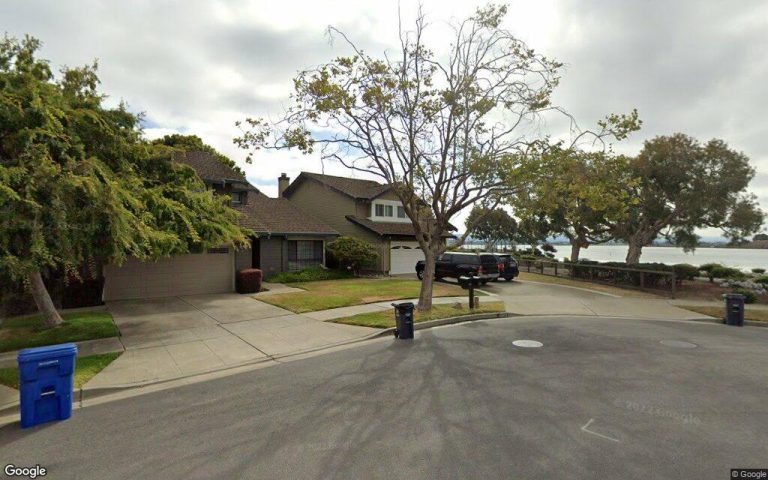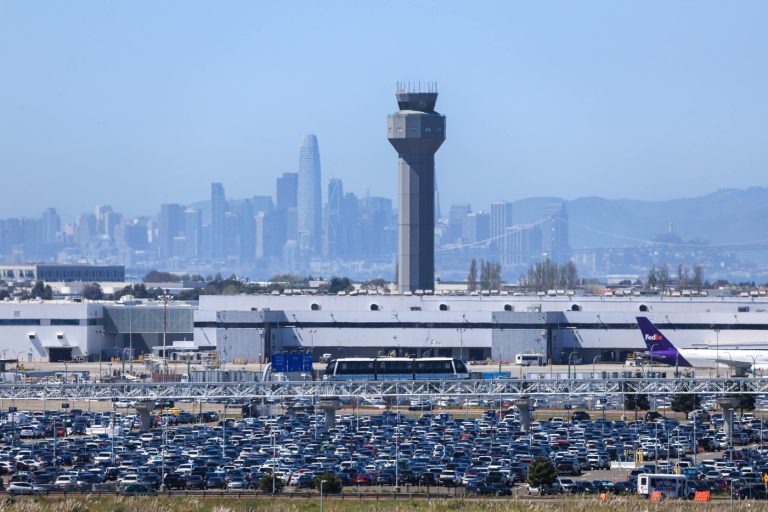At the north end of Wood Street in West Oakland, just outside a cabin shelter village that houses dozens of homeless people who until about a year ago lived at a sprawling encampment in the area, the mangled husks of three abandoned vehicles sat tipped over on their sides. Piles of trash, shopping carts and other debris lined the street. Holes had been cut in the chain-link fence meant to protect cabin residents from intruders.
Aaron Daley said city outreach teams helped move him into one of the shelters last year as authorities finished clearing the Wood Street encampment, which garnered national attention as one of the largest anywhere in the country. Like other cabin residents who gathered a few blocks away Wednesday to commemorate the anniversary of the final dismantling of the camp and call for five weeks of “action in solidarity” against sweeps, Daley said life in the city-run shelters can be chaotic.
“They made these promises that they were going to provide services that were going to help us reintegrate,” Daley said. “What they did was create a storage area for homeless people.”
A drone view of city-created 100-bed cabin shelters on the site of the former Wood Street homeless encampment in West Oakland, Calif., on Wednesday, April 10, 2024. (Jane Tyska/Bay Area News Group)
At its height, Wood Street was home to around 300 people living in a maze of tents, RVs and makeshift dwellings spread across multiple vacant lots in an industrial neighborhood near Interstate 880.
The encampment was beset by fires and other safety hazards, officials said. But it was also the site of what camp residents and advocates described as several self-sustaining communities. A group called Cob on Wood built an un-permitted community center. An area known as the Commons offered a communal kitchen, outdoor meeting space and a free store.
Court rulings delayed the multi-year push to clear Wood Street, ordering the city and Caltrans, the state’s transportation agency that owned some of the vacant lots, to halt sweeps until officials had enough shelter beds for many living there. Oakland eventually opened the 100-bed tiny cabin village and a safe overnight parking lot for camp residents, though some turned down the city’s offers.
City officials have said the cabin shelters, built with an $8.3 million state grant, are also intended to provide residents with job placement support, case management, counseling and help finding housing. But some residents say they’re struggling to get the help they need.
“I’ve been there a year — I’ve been through four housing navigators,” said one cabin resident, who gave his name as Clutch.
Cabin shelter resident and former Wood Street homeless encampment resident “Clutch,” heads back home after the press conference sponsored by Wood Street Commons on 26th Street near Wood Street in West Oakland, Calif., on Wednesday, April 10, 2024. (Jane Tyska/Bay Area News Group)
In a statement, Oakland officials said the city prioritizes “resident safety, well-being, and successful transitions to available permanent housing.” They said since March of last year, the city has worked with 139 cabin shelter residents to find housing and helped eight move into lasting homes.
Officials said 12 residents declined housing because of a unit’s size or location, among other reasons. They added that 120 residents “were successfully able to complete their housing plans” but did not immediately elaborate on whether that meant residents found permanent housing.
“The cabin program’s success is dependent on the participants’ ability and willingness to work with staff and make progress on their own plan,” the city said.
The anniversary comes as public frustration continues to mount over street homelessness and city officials’ seeming inability to get a handle on the crisis.
In response, Gov. Gavin Newsom, who slammed the court decisions blocking the Wood Street sweeps, tapped Caltrans last month to help Oakland clear more encampments near major freeways. The governor has also sent the city tens of millions of dollars to dismantle more camps and create new homeless housing and shelters with supportive services.
Related Articles
Letters: A bad start | Developers’ benefit | Support disabled | Cleanup detail | Travesty of justice | Not self-defense
Antioch clears out another unhoused encampment
Report: State hasn’t been tracking homeless programs’ effectiveness
California college students call on lawmakers to combat student housing crisis
Los Gatos Chamber seeks artwork for street pole banners
But facing a staggering fentanyl epidemic, an overburdened mental health system and a severe shortage of affordable housing, Oakland, like cities across the Bay Area and the state, faces a daunting challenge in moving people off the street and into lasting homes.
“The city does not have the resources to relocate all encampments that present health and safety threats,” Oakland Public Works Director G. Harold Duffey wrote in a recent city report outlining the city’s agreement with Caltrans.
Homeless advocates take part in a press conference sponsored by Wood Street Commons on 26th Street near the former Wood Street homeless encampment in West Oakland, Calif., on Wednesday, April 10, 2024. (Jane Tyska/Bay Area News Group)
Oakland’s estimated homeless population jumped 24% from 2019 to 2022 to more than 5,000 people, about two-thirds of whom live outdoors or in vehicles, according to the latest available data.
Former Wood Street resident LaMonte Ford lives in a Tioga mobile home parked not far from where he used to stay at the camp. Ford said he became homeless after losing his home over a decade ago during the foreclosure crisis. He explained how his struggles have only worsened since he was forced to part with his community at Wood Street.
“I’ve fallen victim to being arrested all over again,” Ford said. “My addiction has picked back up. I’m unemployed. When I had a support team, I was none of those things. I was held. I was sustained. I was taken care of.”












